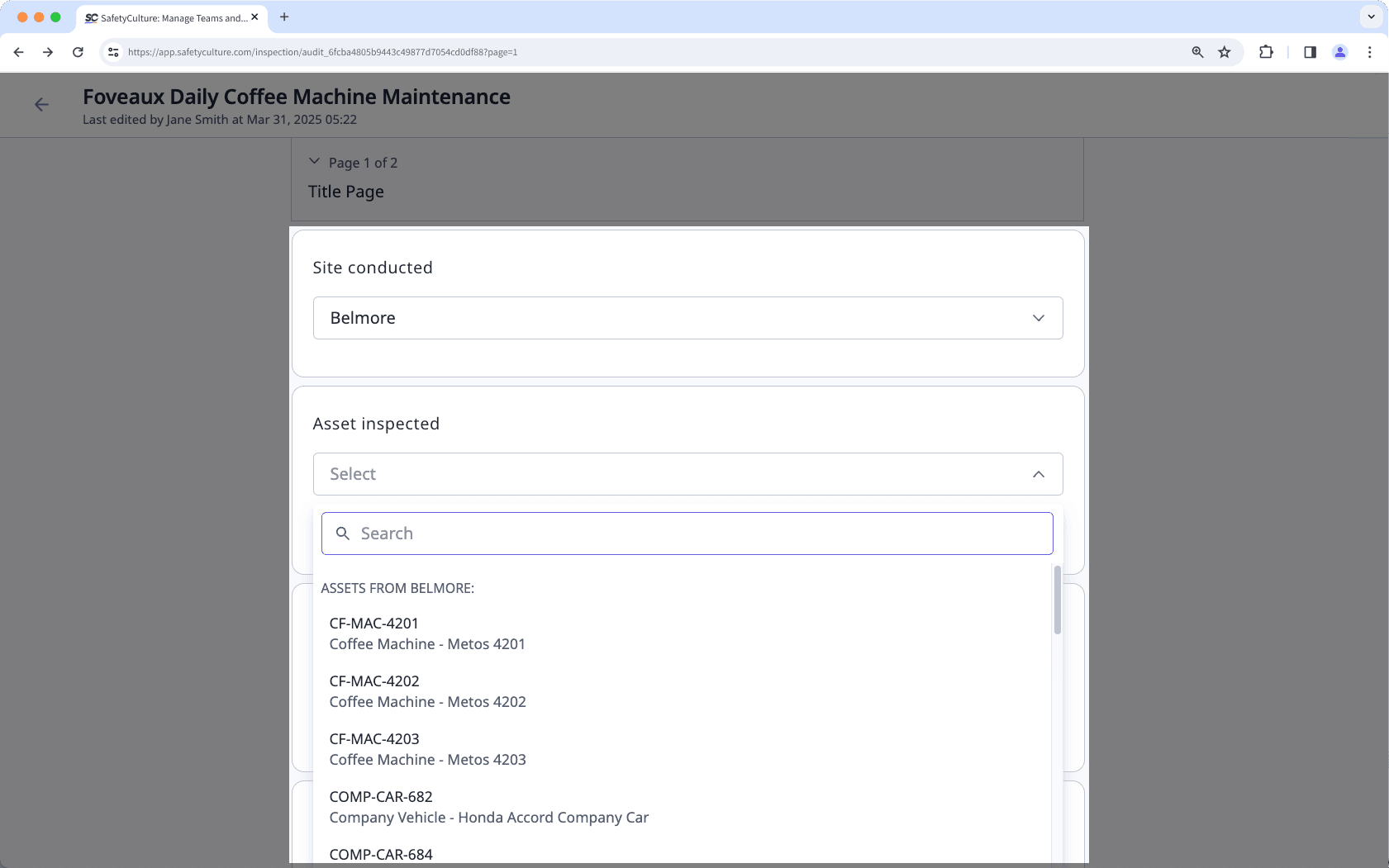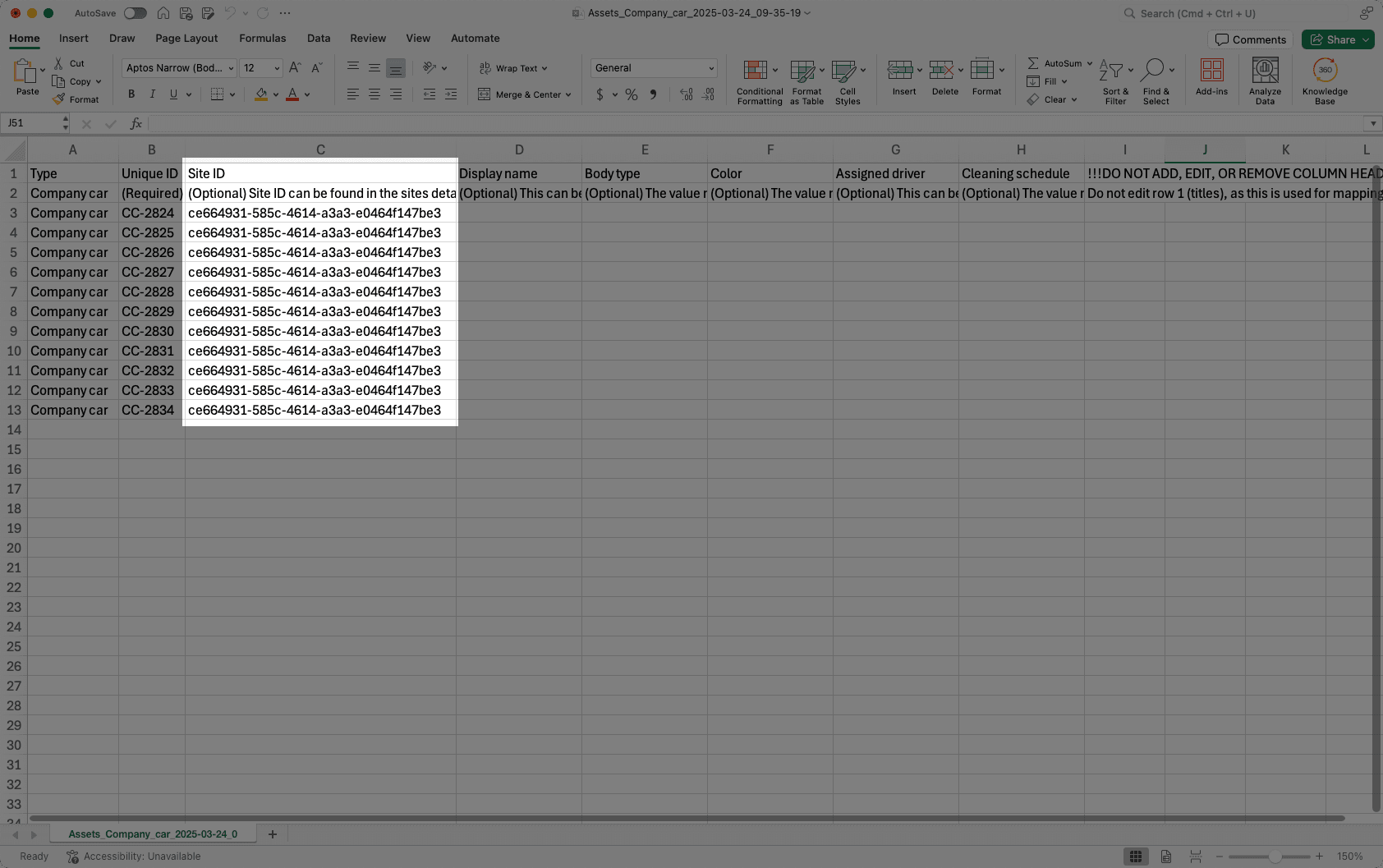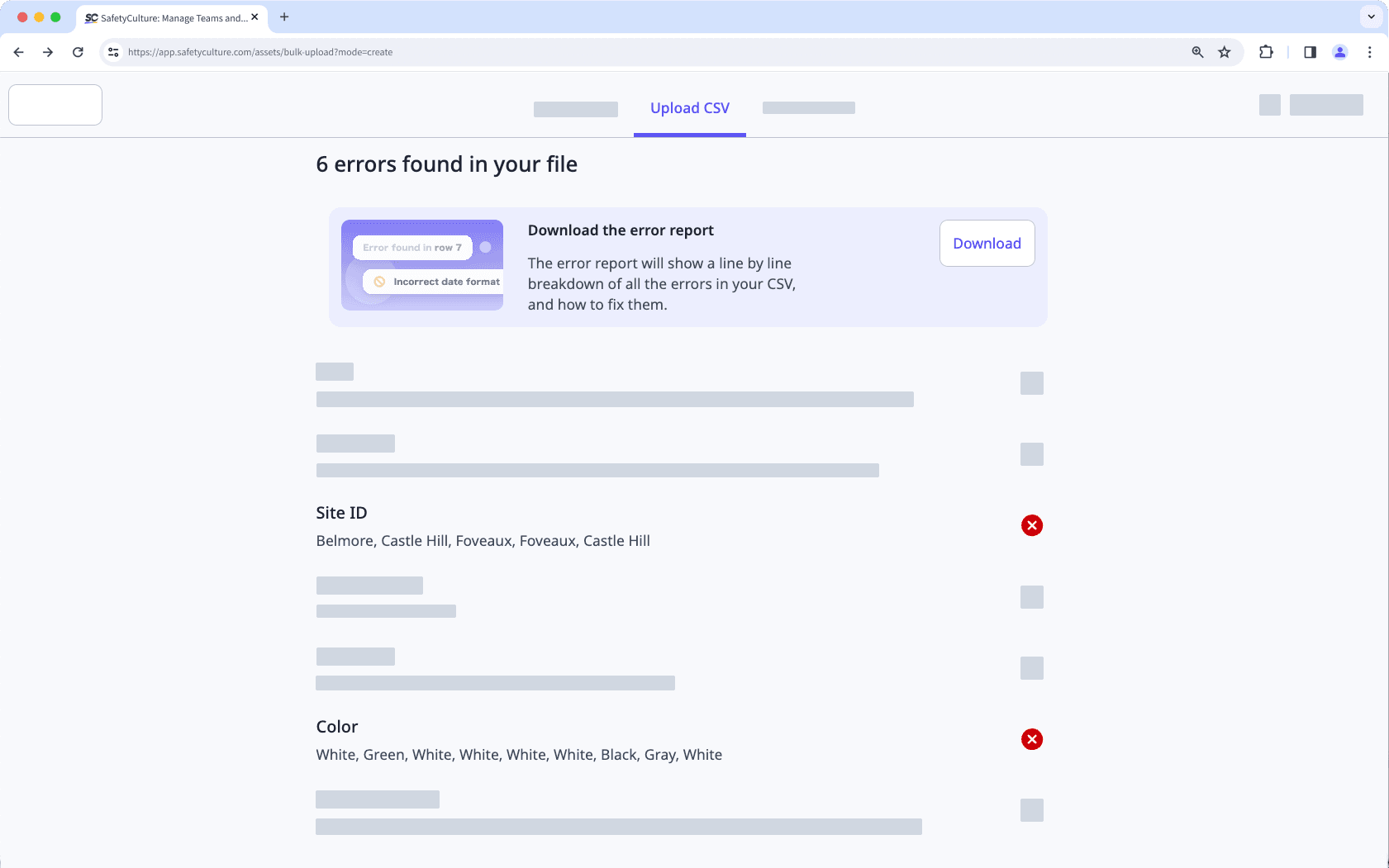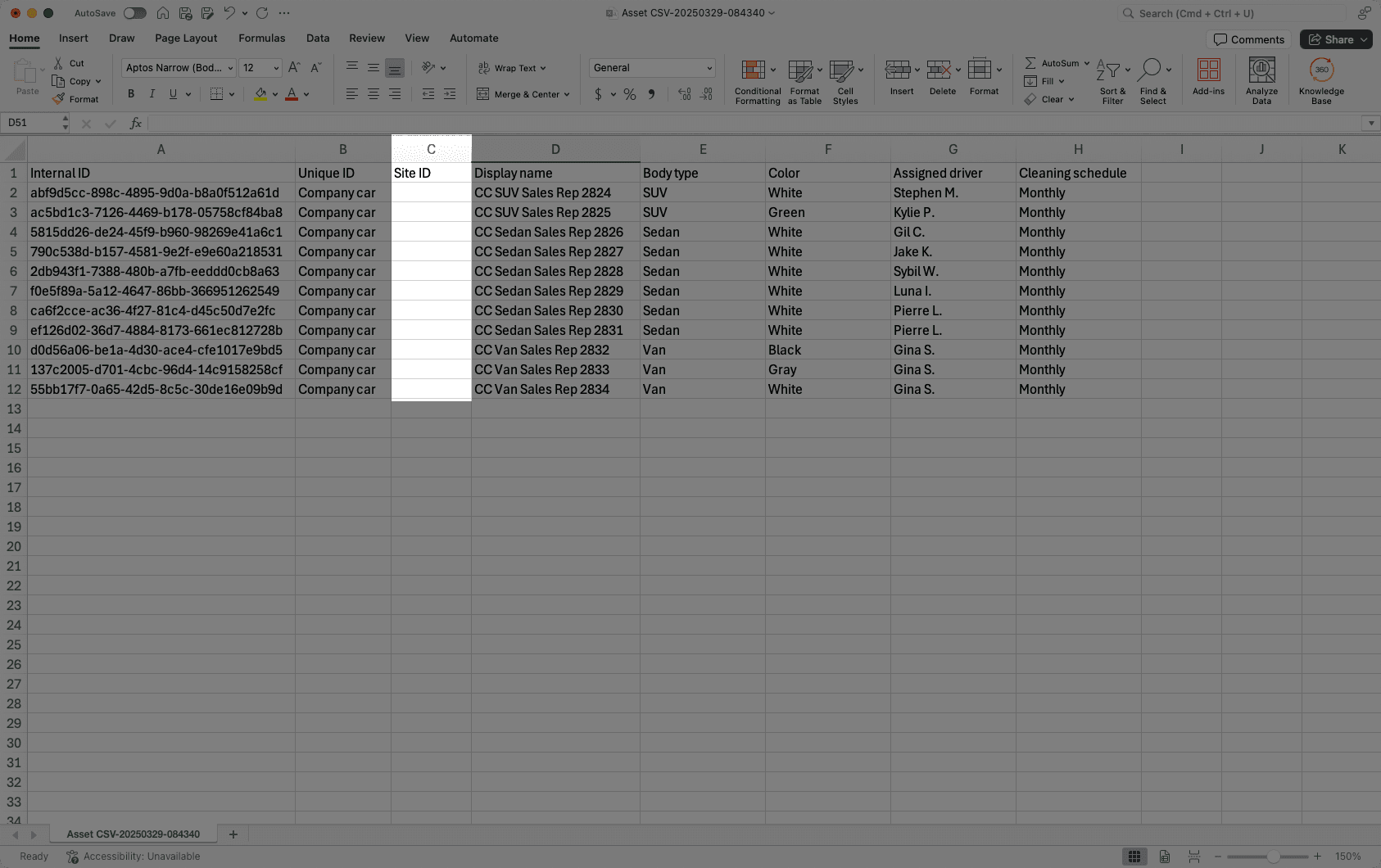- Usar SafetyCulture
- Activos
- Añadir o eliminar activos de sitios en masa mediante CSV
Añadir o eliminar activos de sitios en masa mediante CSV
Aprenda cómo añadir o eliminar activos de un sitio en masa mediante CSV a través de la aplicación web.¿Por qué añadir activos a los sitios?
Añadir activos a sitios ayuda a organizar su lista agrupándolos en ubicaciones o proyectos específicos. Esto facilita la gestión de activos a escala e identifica rápidamente cuáles pertenecen a cada sitio. También mejora el proceso de inspección. Cuando se selecciona un sitio en una inspección, su pregunta sobre activos mostrará primero los activos relevantes de ese sitio. Puede añadir o eliminar activos de los sitios utilizando la lista de activos o mediante CSV.

Añadir activos en masa a un sitio a través de CSV
Seleccione
Activos en la barra lateral o selecciónelo en
Más.
Haga clic en
Añadir activoen la parte superior derecha de la página y seleccione
Añadir activo.
Haga clic en Descargar plantilla CSV.
En la ventana emergente, haga clic en el menú desplegable y seleccione los tipos de activos para los que desee añadir activos. A continuación, haga clic en Hecho y haga clic en Hecho.
Abra la plantilla CSV de cada tipo de activo y prepare sus activos de acuerdo con la sección de la guía CSV para añadir activos.
Una vez que haya terminado, su CSV debería parecerse al siguiente ejemplo:

En Preparar CSV, haga clic en Continuar en la parte inferior de la página.
En Subir CSV, haga clic en
o arrastre y suelte sus archivos.
Si hay algún error, descargue el informe de errores y resuélvalo.

Una vez que esté listo, haga clic en Volver a subir y suba su nuevo CSV.
Haga clic en Continuar en la parte inferior de la página.
En Crear activos, haga clic en Subir otro archivo CSV para añadir más activos o haga clic en Finalizaren la parte inferior derecha de la página.
Guía para CSV
Añada varios activos a la vez utilizando las plantillas CSV para los tipos de activos que haya seleccionado. Asegúrese de que sus columnas y valores coincidan con el formato requerido para evitar errores.
Campos
Cada fila del archivo CSV representa un activo nuevo para el tipo de activo seleccionado. Utilice esta tabla para saber qué significa cada columna, cómo rellenarla y qué campos son obligatorios.
Los nombres de las columnas deben coincidir exactamente con la plantilla CSV. Para añadir nuevos campos de detalle de activos, actualice primero el tipo de activo a través de la aplicación web y, a continuación, descargue una nueva plantilla con esos campos incluidos.
Campo | Descripción |
|---|---|
Tipo (obligatorio) | Introduzca el tipo de activo seleccionado al descargar la plantilla CSV. Este valor debe coincidir con un tipo de activo ya existente en su organización. Cada archivo CSV debe incluir únicamente activos de ese tipo. |
Identificación única (obligatoria) | Introduzca una identificación única para cada activo de su propia organización. Este valor debe ser diferente para cada activo. |
Identificación del sitio | Introduzca la identificación del sitio al que debe asignarse el activo. Las identificaciones de los sitios son cadenas únicas y difieren de los nombres de los sitios. Por ejemplo, el sitio "Belmore" podría tener la identificación de sitio "39c2f508-e0c9-420d-b35f-31fae5f80542". Puede encontrar la identificación del sitio en el perfil del sitio o descargando la lista de sitios de su organización. |
Nombre mostrado | Introduzca el nombre del activo tal como lo conocen los usuarios de su organización. |
Campos de detalles | Los campos de detalles son personalizables, opcionales y dependen de lo que se haya configurado en el tipo de activo. Cada uno aparece como una columna independiente en el archivo CSV. Puede crear campos de detalle en los siguientes formatos: • Texto: este campo es para introducir texto libre, como nombres de operadores, matrículas u otros campos personalizados. • Fecha: introduzca las fechas en el mismo formato que el definido en los ajustes de fecha de su perfil. Por ejemplo, si el formato de fecha de su perfil es «aaaa-MM-dd», deberá escribir las fechas del mismo modo, como «2021-02-21». Según la aplicación que use para preparar el archivo CSV, las fechas podrían ajustarse automáticamente. • Divisa: introduzca las divisas según el código ISO 4217, sin separadores ni caracteres especiales. Por ejemplo, 1.200,95 $ en dólares estadounidenses debe introducirse como «1200,95 USD». • Selección única: introduzca una de las opciones predefinidas que haya establecido para ese campo. |
Consejos para resolución de problemas
Antes de subir su archivo CSV, revise que no haya errores de formato, valores que faltan ni datos que no coinciden. Use esta lista para identificar los errores más comunes y aprender a corregirlos.
Duplicado de identificación única: cada activo debe tener una identificación única. Asegúrese de que no haya dos activos que compartan la misma identificación única.
Falta del tipo de activo: todos los activos deben incluir un tipo que coincida con el tipo de activo seleccionado al descargar la plantilla CSV.
Identificación de sitio no válida: las identificaciones de sitio son cadenas únicas que identifican los niveles de sitio más bajos de su organización. No introduzca el nombre del sitio en lugar de la identificación. Si tiene previsto asignar activos a sitios, asegúrese de obtener las identificaciones de sitio correctas antes de subir su archivo CSV.
Fechasincorrectamenteformateadas: asegúrese de que cada fecha tenga el mismo formato que su formato de fecha del perfil.
Valores de monedaformateadosincorrectamente: cada moneda debe basarse en el código ISO 4217, que no tiene comas ni caracteres especiales.
Nombre de opción de selección no válido: Asegúrese de introducir un valor que coincida con una de las opciones predefinidas para el campo de selección única.
Acceso requerido: es posible que no tenga acceso al activo. Compruebe su nivel de acceso o póngase en contacto con su administrador.
Editar activos en masa para añadir a un sitio a través de CSV
Seleccione
Activos en la barra lateral o selecciónelo en
Más.
Haga clic en
en la parte superior derecha de los activos y seleccione
.

Haga clic en Descargar activos existentes.
En la ventana emergente, haga clic en el menú desplegable y seleccione el tipo de activo para el que quiere editar activos. A continuación, haga clic en Descargar.
Abra la plantilla CSV de cada tipo de activo y prepare sus activos de acuerdo con la sección de la guía CSV para editar activos.
Una vez que haya terminado, su CSV debería parecerse al siguiente ejemplo:

En Preparar CSV, haga clic en Continuar en la parte inferior de la página.
En Subir CSV, haga clic en
o arrastre y suelte sus archivos.
Si hay algún error, descargue el informe de errores y resuélvalo.

Una vez que esté listo, haga clic en Volver a subir y suba su nuevo CSV.
Haga clic en Continuar en la parte inferior de la página.
En Actualizar activos, haga clic en Subir otro archivo CSV para añadir más activos o haga clic en Finalizaren la parte inferior derecha de la página.
Guía para CSV
Edite varios activos a la vez utilizando las plantillas CSV para los tipos de activos que haya seleccionado. Asegúrese de que sus columnas y valores coincidan con el formato requerido para evitar errores.
Campos
Cada fila del archivo CSV representa un activo existente para el tipo de activo seleccionado. Utilice esta tabla para saber qué significa cada columna, cómo rellenarla y qué campos son obligatorios.
Los nombres de las columnas deben coincidir exactamente con la plantilla CSV. Para añadir nuevos campos de detalle de activos, actualice primero el tipo de activo a través de la aplicación web y, a continuación, descargue una nueva plantilla con esos campos incluidos.
Campo | Descripción |
|---|---|
Identificación interna | Un identificador único generado automáticamente en SafetyCulture tras la creación de un activo. Facilita el seguimiento de cada activo en el sistema. No introduzca nada ni edite este campo. |
Identificación única (obligatoria) | Introduzca una identificación única para cada activo de su propia organización. Este valor debe ser diferente para cada activo. |
Identificación del sitio | Introduzca la identificación del sitio al que desea asignar el activo. Las identificaciones de sitio son cadenas únicas y no coinciden con los nombres de los sitios. Por ejemplo, un sitio llamado «Belmore» podría tener la identificación de sitio «39c2f508-e0c9-420d-b35f-31fae5f80542». Puede consultar la identificación del sitio en el perfil del sitio o descargando la lista de sitios de su organización. |
Tipo (obligatorio) | Esta columna se rellena automáticamente según el tipo de activo seleccionado. Cada archivo CSV solo debe incluir activos de ese tipo. |
Nombre mostrado | Introduzca el nombre del activo tal como lo conocen los usuarios de su organización. |
Campos de detalles | Los campos de detalle son columnas opcionales que dependen del tipo de activo que haya seleccionado. Cada uno aparece como una columna independiente en el archivo CSV y debe seguir el formato definido para ese campo. • Texto: este campo es para introducir texto libre, como nombres de operadores, matrículas u otros campos personalizados. • Fecha: introduzca las fechas en el mismo formato que el definido en los ajustes de fecha de su perfil. Por ejemplo, si el formato de fecha de su perfil es «aaaa-MM-dd», deberá escribir las fechas del mismo modo, como «2021-02-21». Según la aplicación que use para preparar el archivo CSV, las fechas podrían ajustarse automáticamente. • Divisa: introduzca las divisas según el código ISO 4217, sin separadores ni caracteres especiales. Por ejemplo, 1.200,95 $ en dólares estadounidenses debe introducirse como «1200,95 USD». • Selección única: introduzca una de las opciones predefinidas que haya establecido para ese campo. |
Consejos para resolución de problemas
Antes de subir su archivo CSV, revise que no haya errores de formato, valores que faltan ni datos que no coinciden. Use esta lista para identificar los errores más comunes y aprender a corregirlos.
No se encontró ninguna identificación interna: SafetyCulture genera automáticamente una identificación interna tras crear un activo. No debe introducirla ni editarla.
Duplicado de identificación única: cada activo debe tener una identificación única. Asegúrese de que no haya dos activos que compartan la misma identificación única.
Falta del tipo de activo: todos los activos deben incluir un tipo que coincida con el tipo de activo seleccionado al descargar la plantilla CSV.
Identificación de sitio no válida: las identificaciones de sitio son cadenas únicas que identifican los niveles de sitio más bajos de su organización. No introduzca el nombre del sitio en lugar de la identificación. Si tiene previsto asignar activos a sitios, asegúrese de obtener las identificaciones de sitio correctas antes de subir su archivo CSV.
Fechasincorrectamenteformateadas: asegúrese de que cada fecha tenga el mismo formato que su formato de fecha del perfil.
Valores de monedaformateadosincorrectamente: cada moneda debe basarse en el código ISO 4217, que no tiene comas ni caracteres especiales.
Nombre de opción de selección no válido: Asegúrese de introducir un valor que coincida con una de las opciones predefinidas para el campo de selección única.
Acceso requerido: es posible que no tenga acceso al activo. Compruebe su nivel de acceso o póngase en contacto con su administrador.
¿Esta página le fue de ayuda?
Gracias por hacérnoslo saber.